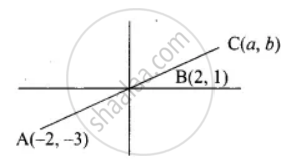Advertisements
Advertisements
Question
A line segment AB is increased along its length by 25% by producing it to C on the side of B. If A and B have the coordinates (−2, −3) and (2, 1) respectively, then find the coordinates of C.
Solution
Let the point C be (a, b)
Distance = `sqrt((x_2 - x_1)^2 + (y_2 - y_1)^2`
AB = `sqrt((2 + 2)^2 + (1 + 3)^2`
= `sqrt(4^2 + 4^2)`
= `sqrt(16 + 16)`
= `4sqrt(2)`
BC = 25% of AB
= `25/100 xx 4sqrt(2)`
= `sqrt(2)`
`"AB"/"BC" = (4sqrt(2))/sqrt(2)` = 4
The ratio is 4 : 1 (m : n)
A line divides internally in the ratio m : n
The point P = `(("m"x_2 + "n"x_1)/("m" + "n"), ("m"y_2 + "n"y_1)/("m" + "n"))`
The point B = `(4"a" - 2)/(4 + 1), (4"b" - 3)/(4 + 1)`
(2, 1) = `(4"a" - 2)/5, (4"b" - 3)/5`
`(4"a" - 2)/5` = 2
4a – 2 = 10
4a = 12
a = `12/4` = 3
and
`(4"b" - 3)/5` = 1
4b – 3 = 5
4b = 8
b = `8/4` = 2
The co-ordinate of C is (3, 2)
APPEARS IN
RELATED QUESTIONS
Find the coordinates of the point which divides the line segment joining the points A(4, −3) and B(9, 7) in the ratio 3 : 2
In what ratio does the point P(2, −5) divide the line segment joining A(−3, 5) and B(4, −9)
Find the coordinates of a point P on the line segment joining A(1, 2) and B(6, 7) in such a way that AP = `2/5` AB
Find the coordinates of the points of trisection of the line segment joining the points A(−5, 6) and B(4, −3)
The line segment joining A(6, 3) and B(−1, −4) is doubled in length by adding half of AB to each end. Find the coordinates of the new end points.
If the coordinates of the mid-points of the sides AB, BC and CA of a triangle are (3, 4), (1, 1) and (2, −3) respectively, then the vertices A and B of the triangle are
